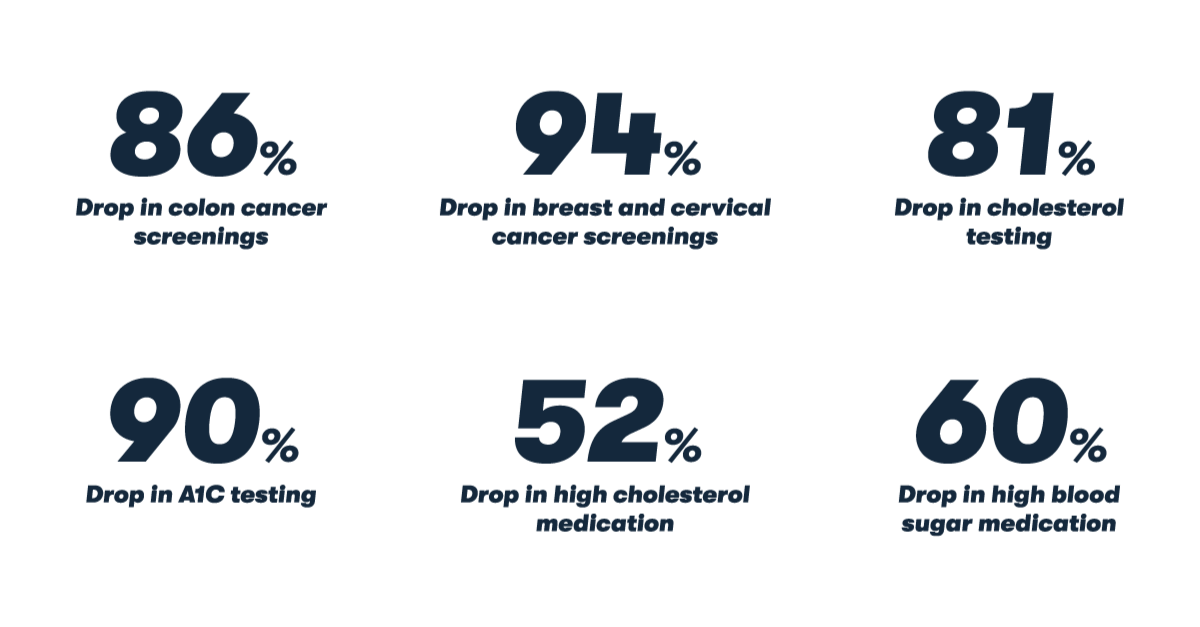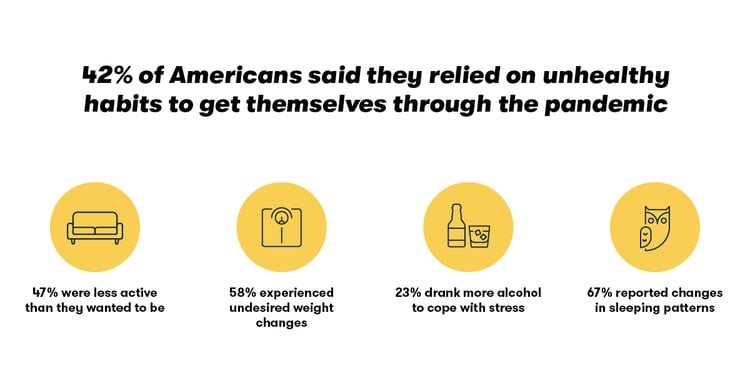When the COVID-19 pandemic first struck, many believed that life would return to normal in just a few weeks. We've just passed the two-year mark of the pandemic's inception. The world is busy creating a new normal and still grappling with how the pandemic impacted physical and mental health, the economy, and work as we knew it.
Over the past two years, many pandemic statistics looked at the threat and spread of COVID-19. Instead, this blog will look at the unforeseen consequences of the pandemic on physical and mental health and how employers can begin to change the trajectory of employee health.
How did the pandemic impact Americans' emotional health?
The Harris Poll began conducting a weekly survey series starting March 15, 2020 to create a comprehensive data set on life amid the pandemic. Their paper "The Great Awakening," which summarized one year of this survey data, outlines the emotional toll the pandemic had on Americans.
At the height of the pandemic, the polls showed:
- 54% of Americans were afraid of dying from the virus.
- 53% feared losing their jobs.
- 50% of Americans felt lonely.
- 39% felt overwhelmed.
- 38% felt claustrophobic.
One year into the pandemic, polls showed:
- 78% of Americans attribute the pandemic as a significant source of stress.
- 35% have been more depressed since the start of the pandemic.
- 31% have experienced increased stress about their own mental health.
The poll conducted in February/March 2022 in partnership with the American Psychological Association (APA) found that:
- 63% of Americans feel their lives have been forever changed.
- 87% agreed it feels like there has been a constant stream of crises over the last two years.
The poll also revealed widespread grief and feelings of loss, continued hardships for vulnerable populations, parents concerned about their children's development, and overall entrenched unhealthy coping habits, all stemming from the implications of the pandemic.
Now, the stress from the pandemic has compounded with additional fear and stress related to the number of crises facing our world right now, including the Russian invasion of Ukraine, rising inflation and supply chain issues.
How did the pandemic alter Americans' physical health?
Americans have accumulated a tremendous amount of health debt since the pandemic began.
Health debt can be described as the accumulative impact of changes in health behaviors that will have long-term adverse effects on health. Health debt has increased over the last two years due to:
- Delayed or missed preventive screenings, leading to more advanced cancer, illnesses and ailments
- Delayed treatment of existing diseases
- Forgone chronic condition management activities
- Changes in lifestyle that negatively impact health

Sources: Cancer screening rates, Cholesterol/A1C testing and medication rates
The combined work of the APA and the Harris Poll gives us a clue into how lifestyle and behaviors have changed over the last two years. Specifically, 47% of Americans said they relied on many unhealthy habits since the pandemic began, 58% experienced undesired weight changes, and 67% reported changes in their sleeping patterns, which is vital for establishing positive mental health.

Source: Stress in America, American Psychological Association
Confronting the Health Debt Brought On By The Pandemic
The decrease in physical and mental well-being shows that the pandemic has made a lasting impression beyond the threat of infection. These behaviors and risks can lead to dire consequences for individuals, employers and communities based on what we already know preventable health risks can cost an organization today.
We are several years away from understanding the total health and financial impact of delayed care, screenings and unhealthy habits. But that doesn't mean we should take a wait-and-see approach. There's no better time to invest in or rethink your employee wellness program to help eliminate the health debt and get employee health back on track.
Let's look at two essential ways to help reduce health debt in the employee population.
1. Encourage Preventive Care Activities
Including screenings and health risk assessments in your employee wellness program can help initiate a shift toward prevention and even lower healthcare costs by identifying health risks and risk factors before a condition presents itself or becomes severe.
Research shows that primary care relationships are directly linked to higher levels of engagement in preventive care and a higher likelihood that individuals who catch issues early will seek treatment. Both help drive down long-term claims and prevent unnecessary short-term claims.
2. Help Employees Identify Unhealthy Habits
Completing a health risk assessment as part of a workplace wellness program will help improve employee health by delivering a real-time understanding of which health habits need the most attention.
Drive engagement in these activities by allocating an incentive to their completion, clearly communicating the value of these activities and reassuring employees that their employer will never see their personal health information.
3. Provide Resources to Create Positive, Long-Lasting Behavior Change
Once employees become conscious of their habits and health risks, they can work to change their lifestyle to lead the healthiest life possible. But it's not as simple as knowing what to change. Many habits require much more than willpower to break down, especially ones that have been engrained over years.
You can deploy many different programs and resources (also known as interventions) in your employee wellness program, from disease management and prevention programs to one-on-one health coaching to online video courses. Use the below criteria to vet these interventions to make sure you have the right programs in place:
- Evidence-based. An evidence-based approach constantly looks at new research and studies and re-evaluates practice based on findings.
- Comprehensive. Interventions should cover diverse goals or health risks, and can support additional facets of employee well-being that may be outside the box of traditional wellness programs, such as emotional or financial well-being.
- Accessible. Members know they are available and can easily engage on a frequent basis to remain engaged over time.
- Personalized. Interventions must be supportive on an individual level, providing practical recommendations to overcome obstacles to health improvement.
- Meaningful. Interventions must require real engagement to produce real results.
For more information about the elements of a successful workplace wellness program, check out "The Complete Guide to Building a Corporate Wellness Plan."


